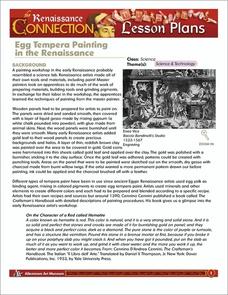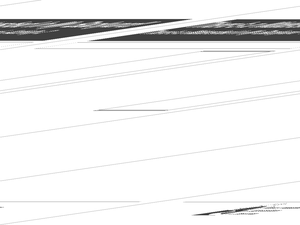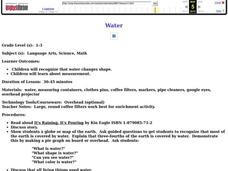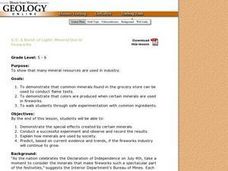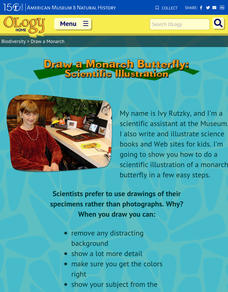Curated OER
Magic Color
First graders discover that a chemical reaction is responsible for the effects seen with Crayola Color Wonder markers. They observe that the color changes are the result of a chemical reaction between chemicals in the Color Wonder paper...
WakeGOV
Plastic Sight Words
Plastic math? Have young learners count and name the number of plastic items in their centers. Kindergartners match sight word cards to the number of plastics in a given group, while learning that plastics come in all different shapes,...
Dick Blick Art Materials
Very, Very Simple Decorative Papers
Combine art and science with an activity that has kids gathering items from their environment to include in the decorative paper they create.
Curated OER
Blinded by the Light
Students recognize that the colors they see are a result of the reflection of light. In this light and color lesson plan, students predict what color will be produced when lights are mixed. They identify the three primary colors and...
Curated OER
Children's Literature Across the Curriculum Ideas: Chickens Aren't the Only Ones
Students read Chickens Aren't the Only Ones by Ruth Heller. They complete a variety of cross-curricular activities surrounding the study of animals that come from eggs. Included are reading, art, math, science, writing, social studies,...
Curated OER
Under Water Scene
Middle schoolers explore foreground and background colors. In this visual art lesson, students create an underwater collage from varying colors and textures of paper showcasing the color transition between background and foreground colors.
Curated OER
Egg Tempera Painting In The Renaissance
Students explore the development of paint and paintings during the Renaissance. In a science lab, they reproduce the properties of egg in tempera paint and compare and contrast egg tempera paintings to oil paintings. Through...
Curated OER
How to Build a Salt-Dough Volcano
Students build a salt dough volcano. They the salt dough using the following ingredients: flour, salt, and water. Students mix flour and salt in a container and add water and mix until the dough is smooth. They then make the volcano....
Curated OER
Visual Models of Solutions and Concentrations
Young scholars model solutions with beakers of colored glass or plastic spheres. In this solutions lesson plan, students use beakers of colored spheres to represent pure substances. They mix the spheres to demosntrate solutions. They...
Curated OER
There's a Watershed in my Backyard!
Students explain what the term watershed is by creating a model. For this science, geography lesson, students demonstrate how the water moves in a watershed. Additionally, students learn about point source and nonpoint source pollution....
Curated OER
Water
Learners complete activities to examine the properties of water. In this water science lesson, students read a book about water's forms and study a map or globe of the Earth to investigate water. Learners discuss living things that need...
Curated OER
Yeast Blowup
Students experiment to determine if yeast is a microorganism. In this yeast blowup lesson, students mix yeast with other ingredients and observe the results by using a balloon. Students adjust the amounts of the ingredients and test...
Curated OER
Contrast- Printmaking- The Fin Art of Science
Learners explore the art of printmaking. They discuss relief prints and the art of fish printing (Gyotaku). They view examples of the artwork of Gyotaku and also observe the various characteristics of different species of fish. Finally...
Curated OER
Color Principles - Hue, Saturation, and Value
Students identify different color models and the application of the color theory. They create different visualizations that compare color models.
American Museum of Natural History
All About Horses
Horses come in all shapes and sizes, but all belong to the same species. Young scholars explore the different traits and connect the information to genetic modification. The interactive gives them the option to read about 18 different...
Curated OER
A Burst of Light: Mineral Use in Fireworks
Students examine the role of minerals in industries. They use minerals that are found in the grocery store to complete flame tests. They complete an experiment using fireworks.
Curated OER
Bioluminescence 2009: Living Light on the Deep Sea Floor Expedition - Now You See Me, Now You Don't
Students examine bioluminescence and camouflage of deep sea creatures. In this deep sea creatures lesson, students investigate the visible and near-visible light spectrum. They work in small groups to complete a light, color, and...
American Museum of Natural History
Draw a Monarch Butterfly: Scientific Illustrations
One doesn't have to be an artist to appreciate nature. A thorough resource shows pupils how to create detailed illustrations of a monarch butterfly. The lesson highlights the benefits of creating scientific drawings as opposed to simply...
Curated OER
April Showers Raindrop Painting
I love this idea! After discussing rain, spring, and the weather, take your class outside and let nature do the painting. They shake power paints and glitter onto a piece of heavy construction paper, then take their paper outside and...
Beyond Benign
PPM
The 15th lesson in the series of 24 helps your classes understand the ppm (part per million) unit of measure. First, scholars experiment with food coloring to determine concentrations before applying their findings to calculate...
Curated OER
Following Instructions
Get scholars thinking about the scientific process with this fun experiment they can do at home. Learners practice reading directions as they underline each instruction in a procedural paragraph. They create a flow chart and record...
Curated OER
Twirly Whirly Milk
Student observe the effect soap (or detergent) has on the movement of food color in milk. Pupils observe the properties of solids and liquids while making butter. They read a poem, Shaking, and listen for ryhming words. Studdents...
Curated OER
Observation Milk Fat Lesson
Turn your class loose to experiment with the different fat content in skim milk, whole milk, half and half, and heavy cream. This is a visually vibrant experiment, as learners drip food coloring on the surface of the products and measure...
California Academy of Science
Discovering Rainforest Locations
How many rainforests are there, where are they, and do global factors effect their locations? These are great questions that have great answers. Children in grades four through eight use several different maps to determine why...






